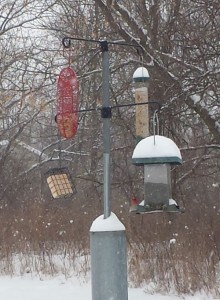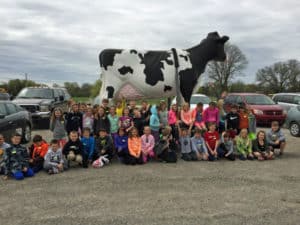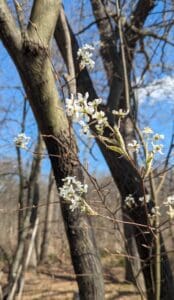
By Jennifer Fairfield, owner of the Garden Mill
(Publisher’s note: Part one published yesterday.)
Trees and Shrubs:
The only pruning of trees and shrubs that should be done between now about February is to remove dead or damaged branches, so avoid the temptation of trimming back unruly stuff. It can and should wait.
While the ground is still soft, put up stakes to use to attach burlap to for wind barriers around evergreen trees and shrubs. You can wait a little bit to put the burlap up, but having the stakes in place now means you aren’t trying to pound them into the frozen ground.
Once the ground is frozen, it’s time to protect evergreens from the harsh, cold winds of winter, as well as from the sun – believe it or not. the University of Minnesota Extension Service offers a great resource for information on what issues trees and shrubs may face over the winter, and how to deal with them.
While Mother Nature seems to have been determined lately to make up for the lack of rain all summer, that could easily change again, so keep hoses handy while the temperatures are still above freezing, so that you can water your trees and shrubs if we aren’t getting at least an inch of rain each week. This will help to prevent damage caused by the drying winds we get all winter. Be sure to fully empty hoses after each use at this time of year so that you don’t risk having the water in them freeze and expand, causing the hose to crack when temperatures dip below freezing at night.
As with your flower beds, add a layer of fresh mulch to trees and shrubs, once the soil has cooled, to help them get through the winter.
Lawn and Leaves:
Lawns are probably about done growing for the season, with the onset of colder temperatures. If you haven’t mowed recently though, you might want to do one final mow before you put away the equipment. It’s not a good idea to leave the grass too long going into winter, as this can promote disease in your lawn.
It’s also not a great idea to leave whole leaves on your lawn all winter long. So, while you’re doing that last mowing, use your mower to shred the leaves and mulch them into the lawn, instead of raking them up – it’s better for your lawn, and for your back.
Tools:
When you’re all done with your garden clean-up, there’s still a little bit more to be done: clean, dry, sharpen and lubricate your garden tools before you put them away so they’ll be ready to get right to work in the spring. Sharpen your shovels, too. A sharp shovel makes digging so much easier.
Empty your hoses, roll them up, and tie them before hanging them up for the winter. I like to connect the ends of each hose to keep spiders from using them as nesting places. I also like to put my sprinkler heads and wands all in one place, so I don’t have to remember what I did with them next year. A small trug (my favorite garden too) or bucket works well for this. If you have rain barrels, empty them and put them away, too, or consider bringing one or more of them into your basement to use the rain water over the winter. It’s not an easy task – you’ll need some real muscle and, at minimum, a hand truck, but if you can do it, it’s a great way to save water, and using rain water – as opposed to treated water – is much better for your plants.
Here are more great tips on taking care of your tools at the end of the season.

Birds:
Leave your birdbaths out and filled as long as possible. Many birdbaths can’t take being out in freezing temperatures, but you can still fill your birdbaths up during the day, and dump them out in the evening, until daytime temps start going below freezing. If you have a birdbath that can stand up to the freezing temps, consider putting in a de-icer.
De-icers allow you to provide a vital source of water for your birds all through the winter, without risking damaging your birdbath. Another option is a heated birdbath, like the one we carry, that has a built-in heater with temperature control that only heats up when the temps dip below freezing.
If you don’t feed your birds year-round, from now to next spring is the best time to do so. While birds rely mainly on insects during the summer, seeds and berries become the main source of food in the winter for most birds. Providing an easy source of food for them will help them get through the cold days and nights of winter, and let’s you enjoy their antics at the feeders, too. Just remember to clean the feeders regularly to help prevent the spread of disease.














